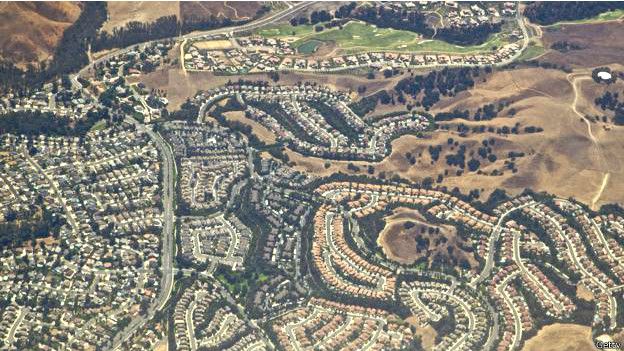How GPS WorksFor those who are unfamiliar with the term, GPS stands for Global Positioning System, and is a way of locating a receiver in three dimensional
space anywhere on the Earth, and even in orbit about it.
GPS is arguably one of the most important inventions of our time, and has so many different applications that many technologies and ways of
working are continually being improved in order to make the most of it.
To understand exactly why it is so useful and important, we should first look at how GPS works. More importantly, looking at what technological
achievements have driven the development of this fascinating positioning system.
SignalsIn order for GPS to work, a network of satellites was placed into orbit around planet Earth, each broadcasting a specific signal, much like
a normal radio signal. This signal can be received by a low cost, low technology aerial, even though the signal is very weak.
Rather than carrying an actual radio or television program, the signals that are broadcast by the satellites carry data that is passed from
the aerial, decoded and used by to the GPS software.
The information is specific enough that the GPS software can identify the satellite, it’s location in space, and calculate the time that the
signal took to travel from the satellite to the GPS receiver.
Using different signals from different satellites, the GPS software is able to calculate the position of the receiver. The principle is very
similar to that which is used in orienteering – if you can identify three places on your map, take a bearing to where they are, and draw
three lines on the map, then you will find out where you are on the map.
The lines will intersect, and, depending on the accuracy of the bearings, the triangle that they form where they intersect will approximate
your position, within a margin of error.
GPS software performs a similar kind of exercise, using the known positions of the satellites in space, and measuring the time that the signal
has taken to travel from the satellite to Earth.
The result of the “trilateration” (the term used when distances are used instead of bearings) of at least three satellites, assuming that the
clocks are all synchronized enables the software to calculate, within a margin of error, where the device is located in terms of its latitude
(East-West) and longitude (North-South) and distance from the center of the Earth.
Timing & CorrectionIn a perfect world, the accuracy should be absolute, but there are many different factors which prevent this. Principally, it is impossible
to ensure that the clocks are all synchronized.
Since the satellites each contain atomic clocks which are extremely accurate, and certainly accurate with respect to each other, we can
assume that most of the problem lies with the clock inside the GPS unit itself.
Keeping the cost of the technology down to a minimum is a key part of the success of any consumer device, and it is simply not possible to
fit each GPS unit with an atomic clock costing tens of thousands of dollars. Luckily, in creating the system, the designers designed GPS to
work whether the receiver’s clock is accurate or not.
There are a few solutions. However the solution that was chosen uses a fourth satellite to provide a cross check in the trilateration process.
Since trilateration from three signals should pinpoint the location exactly, adding a fourth will move that location; that is, it will not
intersect with the calculated location.
This indicates to the GPS software that there is a discrepancy, and so it performs an additional calculation to find a value that it can use
to adjust all the signals so that the four lines intersect.
Usually, this is as simple as subtracting a second (for example) from each of the calculated travel times of the signals. Thus, the GPS
software can also update its’ own internal clock; and means that not only do we have an accurate positioning device, but also an atomic
clock in the palm of our hands.
MappingKnowing where the device is in space is one thing, but it is fairly useless information without something to compare it with. Thus,
the mapping part of any GPS software is very important; it is how GPS works our possible routes, and allows the user to plan trips in advance.
In fact, it is often the mapping data which elevates the price of the GPS solution; it must be accurate and updated reasonably frequently.
There are, however, several kinds of map, and each is intended for different users, with different needs.
Road users, for example, require that their mapping data contains accurate information about the road network in the region that they will
be traveling in, but will not require detailed information about the lie of the land – they do not really worry about the height of hills
and so forth.
On the other hand, hiking GPS users might wish to have a detailed map of the terrain, rivers, hills and so forth, and perhaps tracks and
trails, but not roads. They might also like to adorn their map with specific icons of things that they find along the way and that they
wish to keep a record of – not to mention waypoints; locations to make for on their general route.
Finally, marine users need very specific information relating to the sea bed, navigable channels, and other pieces of maritime data that
enables them to navigate safely. Of course, the sea itself is reasonably featureless, but underneath quite some detail is needed to be sure
that the boat will not become grounded.
Fishermen also use marine GPS to locate themselves and track the movement of shoals of fish both in real time, and to predict where they will
be the next day. The advent of GPS fixing has also meant that co-operative fishing has become much easier, where there are several boats all
relaying their locations to each other while they locate the best fishing waters.
Special kinds of marine GPS, known as fishfinders, also combine several functions in one to help fishermen. A fishfinder comprises GPS and
also sonar, along with advanced tracking functions and storage for various kinds of fishing and maritime information.
Getting StartedThere are a few solutions available to consumers, ranging from sophisticated in-car GPS systems, which feature voice guiding, powerful
dynamic route calculation, and the possibility to update the map from a CD.
Then there are handheld GPS devices, such as those from Magellan and Garmin, which store a map inside, and are usually designed for outdoor
use. They cannot generally perform dynamic route calculation since they do not have any road information, and leave the user to find their
own way from A to B.
Finally, a more recent solution has appeared on the market which uses the power of a PDA to run the actual GPS software, and uses the
interface capability to attach a GPS receiver (antenna) to the unit. These tend to be the cheapest, easiest to use and most flexible
solutions, but are only as rugged as the PDA to which they are attached.
Some recent systems can make use of a wireless Bluetooth connection so that they can be used both as a personal navigation aid and also
inside a vehicle, by having several receives with Bluetooth capabilities, and a single PDA.
 PTI
PTI Getty
Getty Image copyrightPTI
Image copyrightPTI Image copyrightGetty
Image copyrightGetty
